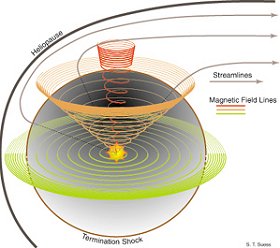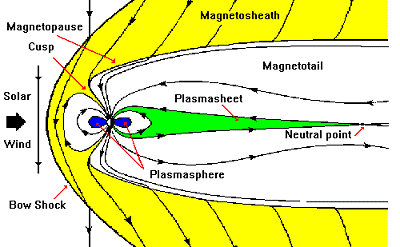The Interplanetary Magnetic
Field
It comes from the Sun!
back
to spaceweather.com
The Sun is a
big magnet.
During solar minimum the Sun's magnetic
field, like Earth's, resembles that of an iron bar magnet, with
great closed loops near the equator and open field lines near
the poles. Scientists call such a field a "dipole."
The Sun's dipolar field is about as strong as a refrigerator magnet,
or 50 gauss. Earth's magnetic field is 100 times weaker.
 During
the years around solar maximum (2000 and 2001 are good examples)
spots pepper the face of the Sun. Sunspots are places where intense
magnetic loops -- hundreds of times stronger than the ambient
dipole field -- poke through the photosphere. Sunspot magnetic
fields overwhelm the underlying dipole; as a result, the Sun's
magnetic field near the surface of the star becomes tangled and
complicated.
During
the years around solar maximum (2000 and 2001 are good examples)
spots pepper the face of the Sun. Sunspots are places where intense
magnetic loops -- hundreds of times stronger than the ambient
dipole field -- poke through the photosphere. Sunspot magnetic
fields overwhelm the underlying dipole; as a result, the Sun's
magnetic field near the surface of the star becomes tangled and
complicated.
The Sun's magnetic field isn't confined
to the immediate vicinity of our star. The solar
wind carries it throughout the solar system. Out among the
planets we call the Sun's magnetic field the "Interplanetary
Magnetic Field" or "IMF."
Because the Sun rotates (once every 27 days) the IMF has a spiral
shape -- named the "Parker
spiral" after the scientist who first described it.
Above:
Steve Suess (NASA/MSFC) prepared this figure, which shows the
Sun's spiraling magnetic field from a vantage point ~100 AU from
the Sun.
Earth has a magnetic field, too. It forms
a bubble around our planet called the magnetosphere,
which deflects solar wind gusts. (Mars, which does not have a
protective magnetosphere, has lost much of its atmosphere as a
result of solar
wind erosion.) Earth's magnetic field and the IMF come into
contact at the magnetopause:
a place where the magnetosphere meets the solar wind. Earth's
magnetic field points north at the magnetopause. If the IMF points
south -- a condition scientists call "southward Bz"
-- then the IMF can partially cancel Earth's magnetic field at
the point of contact.

Above: Earth's
magnetosphere.
From the Oulu
Space Physics Textbook.
"When Bz is south, that
is, opposite Earth's magnetic field, the two fields link up,"
explains Christopher Russell, a Professor of Geophysics and Space
Physics at UCLA. "You can then follow a field line from Earth
directly into the solar wind" -- or from the solar wind to
Earth. South-pointing Bz's open a door through which
energy from the solar wind can reach Earth's atmosphere!
Southward Bz's often herald widespread
auroras, triggered by solar wind gusts or coronal mass ejections
that are able to inject energy into our planet's magnetosphere.
Back to spaceweather.com
 During
the years around solar maximum (2000 and 2001 are good examples)
spots pepper the face of the Sun. Sunspots are places where intense
magnetic loops -- hundreds of times stronger than the ambient
dipole field -- poke through the photosphere. Sunspot magnetic
fields overwhelm the underlying dipole; as a result, the Sun's
magnetic field near the surface of the star becomes tangled and
complicated.
During
the years around solar maximum (2000 and 2001 are good examples)
spots pepper the face of the Sun. Sunspots are places where intense
magnetic loops -- hundreds of times stronger than the ambient
dipole field -- poke through the photosphere. Sunspot magnetic
fields overwhelm the underlying dipole; as a result, the Sun's
magnetic field near the surface of the star becomes tangled and
complicated.